When Do Havanese Go Into Heat? 7 Must-Know Signs
Havanese dog owners, especially new ones, often have concerns and questions about their dog’s heat cycle. Knowing when your Havanese goes into heat and understanding the signs of it is crucial for dog owners to plan accordingly and provide proper care during this period.
The heat cycle is a natural process in a female Havanese’s reproductive system. Generally, Havanese dogs experience their first heat cycle when they are around 6 to 10 months old and it occurs twice a year, typically lasting for 2 to 3 weeks. During this time, Havanese dogs exhibit various physical and behavioral changes.
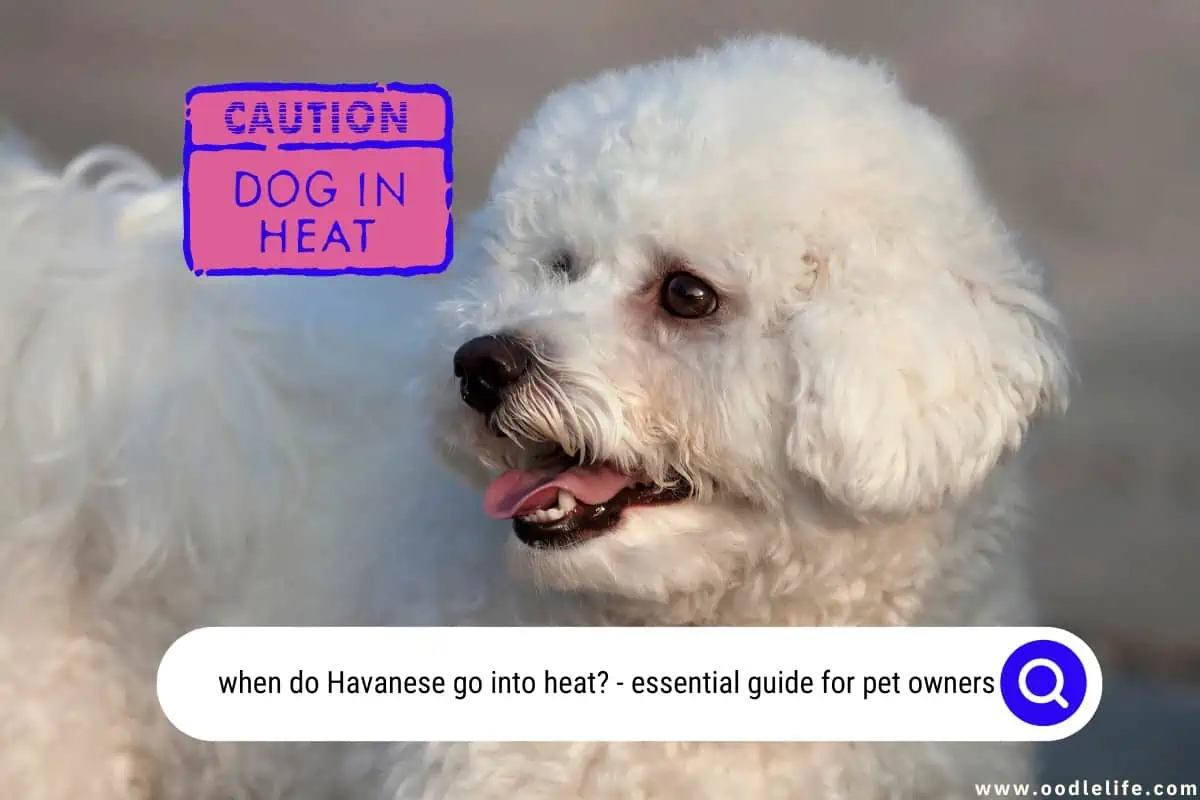
Being well-informed about your Havanese’s heat cycle and knowing how to respond to it will help ensure that your pet is comfortable and well-cared for during this time. Whether you’re planning to breed your Havanese or simply want to be aware of the changes your dog will undergo, understanding the heat cycle is essential.
Key Takeaways
- Havanese dogs generally experience their first heat cycle between 6 to 10 months old.
- Recognizing the signs of heat can help owners provide proper care during this period.
- Consult a veterinarian with any concerns related to your Havanese’s heat cycle or reproductive health.
Understanding Havanese Heat Cycles
Havanese, like all female dogs, experience heat cycles. This is the period when the hormones fluctuate, and they become receptive to mating. Let’s explore the different aspects of Havanese heat cycles by discussing the first heat, various heat cycle stages, and the frequency of heat cycles in Havanese dogs.
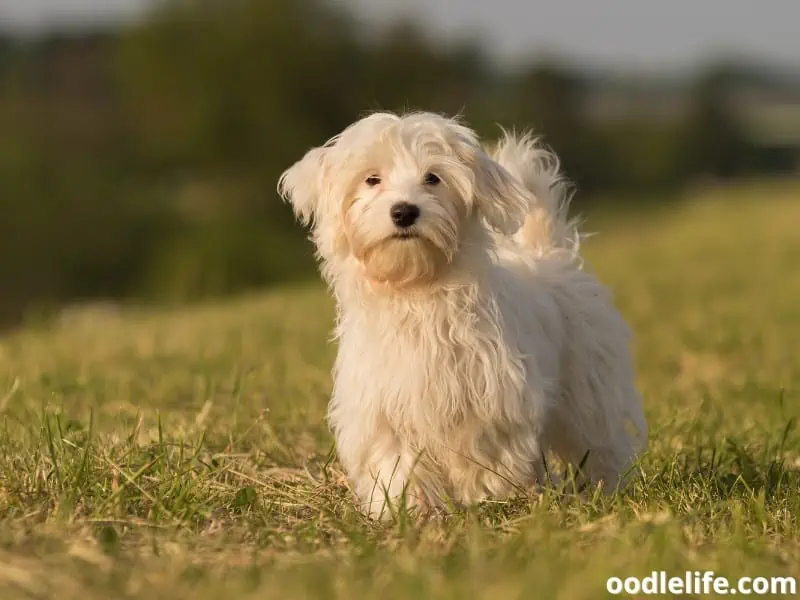
First Heat
Ah, the first heat – a milestone in every young Havanese’s life! For Havanese, the first heat usually occurs between 6-12 months of age. It’s a time when the young dog transitions from being a carefree puppy to a mature adult.
Keep an eye out for physical and behavioral changes in your Havanese pup – it’s a telltale sign that they’re growing up!
Heat Cycle Stages
Now let’s dive into the four stages of the heat cycle in Havanese:
Proestrus: This is the start of the heat cycle, which typically lasts 7-10 days. You might notice your Havanese becoming more affectionate and exhibiting some swelling in their vulva. However, don’t rush to plan a playdate just yet – they’re not quite ready for mating!
Estrus: This stage is where the magic happens. Lasting about 5-14 days, your Havanese is now receptive to breeding. The hormone levels have peaked, and ovulation occurs. Their vulva swelling subsides a little, and you might observe a pinkish discharge.
Diestrus: No more dating for your Havanese! During this stage, which lasts about 60-90 days, your Havanese’s body is either preparing for pregnancy or returning to its non-receptive state. Hormone levels decline, and the vulva returns to its normal size.
Anestrus: The calm before the next hormonal storm. This is the resting phase between heat cycles, lasting about 3-4 months. Your Havanese can enjoy this period of hormonal neutrality before the cycle begins again.
Frequency of Heat Cycles
Now that we’ve covered the stages, you must be wondering how frequently these heat cycles occur for Havanese. On average, Havanese dogs experience heat cycles about twice a year, with intervals of around 6 months. However, every dog is an individual – some Havanese might have more frequent cycles, while others take longer breaks.
In conclusion, understanding your Havanese’s heat cycles is essential to ensure you’re well-prepared for their hormonal roller coaster ride. Keep a close eye on their behavior and physical changes throughout the process, and most importantly, don’t forget to show them some extra love during these challenging times!
Recognizing Signs of Heat in Your Havanese
As a Havanese owner, it’s essential to know when your furry friend goes into heat. Understanding the signs can make the process more manageable for both you and your pup. Let’s dive into the physical signs and behavioral changes to watch out for when your Havanese goes into heat.
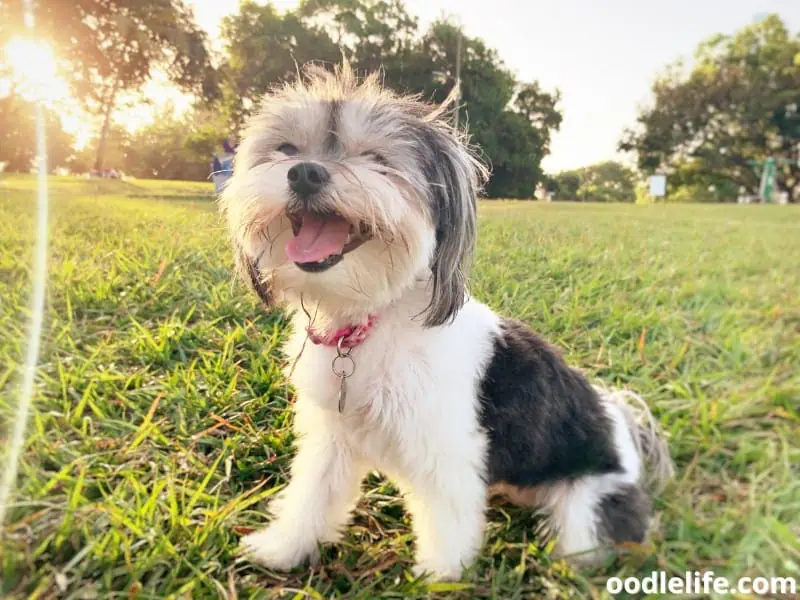
Physical Signs
Keep an eye on your Havanese’s swollen vulva and vaginal discharge. These are common physical signs that she’s entering her heat cycle. You might also notice some vaginal bleeding and frequent urination.
It’s crucial to keep the area clean, so grab some doggy wipes and gently clean the area daily or as needed.
Here’s a little pupper tip: Put a doggie diaper or sanitary pad on your Havanese to prevent any “red alert” surprises on your white carpets.
Behavioral Changes
In addition to physical signs, you might observe some behavioral changes in your Havanese. Hormonal changes can lead to an array of symptoms, such as diarrhea, panting, restlessness, and vocalization. Don’t be shocked if your normally quiet Havanese suddenly turns into a diva!
Your sweet pup might even display some aggression towards other dogs during this time. It’s a good idea to keep your Havanese on a leash and closely supervised during walks to avoid any “misunderstandings” with the neighborhood canine gossip club.
Keep in mind that every dog is unique, and their experience of going into heat may vary. By paying close attention to these signs and changes in your Havanese, you’ll be well-equipped to handle her heat cycles and provide the best care possible.
Quick note: Always remember to keep your sense of humor while navigating the ups and downs of your Havanese’s heat cycle. The process may be challenging, but your pup will appreciate your support and understanding. Plus, you’ll have some hilarious stories to share during your next dog-park hangout!
Proper Care During Havanese Heat Cycle
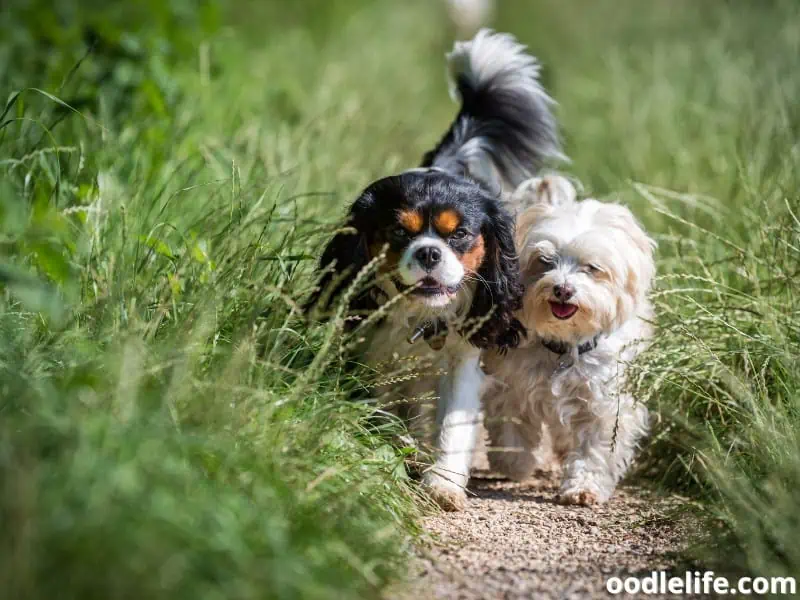
Ensuring Comfort
During the heat cycle, your Havanese may experience some discomfort. To help alleviate this, provide a comfortable and quiet space for her to rest. It’s essential to keep her bedding clean and dry, as there may be some discharge during this time.
Adding some extra padding to her bed can be helpful too.
One way to keep your little diva entertained and distracted is by offering her favorite toys or engaging in gentle playtime. Just remember not to overdo it, as she might not be in the mood for intense activities.
Safety Precautions
To avoid any unwanted pregnancies, it’s important to take some precautions when your Havanese is in heat. Spaying her is a good option, as it not only prevents pregnancy but also eliminates the heat cycle altogether. On the other hand, if you don’t plan on spaying her, be attentive and proactive.
We all know that intact male dogs have an impeccable radar when it comes to detecting a nearby female in heat. So, keep your Havanese on a leash when going for walks, and avoid off-leash dog parks altogether during this time.
Interaction with Male Dogs
It’s crucial to closely monitor your Havanese’s interactions with male dogs, particularly when she’s unspayed and in heat. Intact males might exhibit increased levels of aggression towards your Havanese, trying to assert dominance or mate with her.
Neutering your male Havanese can reduce hormone-driven behaviors, making him less inclined to be aggressive or overly interested in mating. The last thing you want is a testosterone-infused Romeo serenading your little Juliet from across the neighborhood fence!
When handling an unspayed Havanese in heat, it’s crucial to be mindful of these situations and watchful of other dogs during this sensitive time. Precautions and a good sense of humor will go a long way in ensuring both you and your Havanese navigate the heat cycle smoothly.
Mating and Breeding in Havanese

Fertile Window
Havanese typically go into heat, or their estrus cycle, about every 6 months. During this time, their fertile window occurs, which is when they’re able to mate and become pregnant. The estrus cycle can be divided into four stages: proestrus, estrus, diestrus, and anestrus.
In the proestrus stage, a Havanese may display an increase in urination, and their vulva may begin to swell. This lasts about 9 days and is followed by the estrus stage, where the female is receptive to mating. This stage lasts around 9 days as well, providing a relatively brief opportunity for successful mating.
Breeding Considerations
Before allowing your Havanese to mate, it’s important to think about their health and temperament. A healthy, confident, and well-socialized Havanese are more likely to have a successful mating experience. Consult with a veterinarian to ensure their overall health is in optimal condition for breeding.
Additionally, think about the prospective partner’s attributes as well. As the saying goes, “Like attracts like,” so choose a mate with the desirable characteristics you’d like to see passed down to the puppies.
Pregnancy and Whelping
After a successful mating, a Havanese’s pregnancy will last around 63 days. During this time, they should receive proper prenatal care from a veterinarian to ensure the healthiest outcome for both the mother and her puppies.
As the big day approaches, prepare a calm and comfortable whelping area for the Havanese to give birth. Be sure to keep a close eye on her during labor, as things can sometimes get complicated. Remember, even though it seems like a doggone miracle, birth is a natural process, and our furry friends usually know what to do.
But it’s always good to have the veterinarian’s number handy, just in case.
In summary: Mating and breeding for Havanese dogs rely on properly identifying their fertile window and partnering them with a suitable mate. Ensuring the health and well-being of both parents and their future puppies is a top priority. So trust your instincts, and keep the lines of communication open with your trusty veterinarian throughout the entire process.
Happy breeding!
When to Consult a Veterinarian?
Health Concerns During Heat
The heat cycle in a Havanese dog can throw some curveballs at you in terms of health and behavior. You may notice some appetite changes, restlessness, or even vomiting. It’s important to keep an eye on your furry friend and consult a veterinarian if anything seems out of the ordinary.
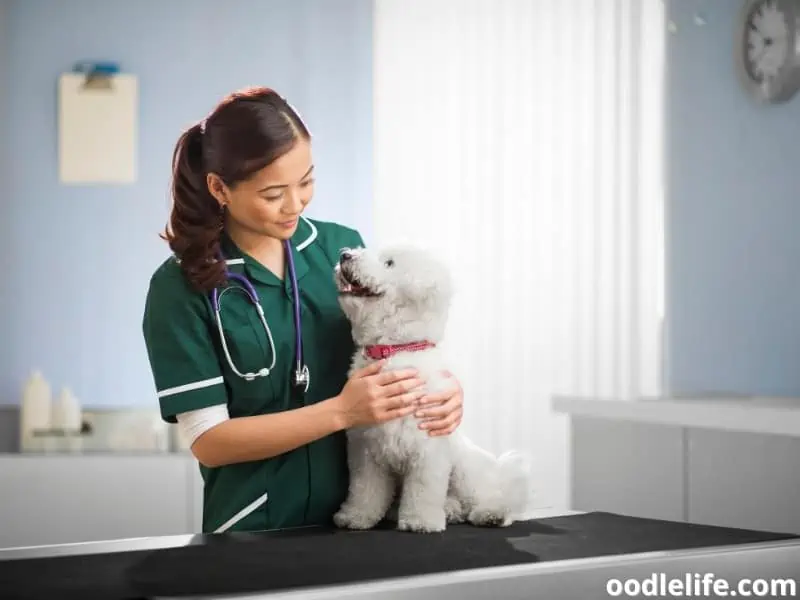
For example, let’s say your normally well-behaved Havanese suddenly starts acting like a rebellious teenager. You find yourself saying things like “Not on the carpet!” more often than you’d like to admit. It could be a simple behavioral change due to the heat cycle, but consulting your veterinarian can help rule out any underlying health concerns.
Remember, even though your dog may be giving you their best puppy-dog-eyes, now is not the time to cave into their every whim, like begging for table scraps. Keep in mind that a balanced diet and proper care during the heat cycle are crucial to their well-being.
Deciding on Spaying or Neutering
To spay or not to spay, that is the question many Havanese owners face during the heat cycle. While some may opt for spaying as a way to avoid future heat cycles and potential health problems, others may decide to keep their dog intact for various reasons, like breeding or personal preferences.
No matter which direction you’re leaning, it’s essential to have a conversation with your veterinarian about the pros and cons of spaying and neutering. They will be able to provide you with expert advice and guidance on the best course of action for your specific dog and situation.
For instance, you might witness your Havanese marking their territory with a newfound “eau de dog” scent, and think, “Well, that seals it—time to schedule a spaying appointment!” But before you make any hasty decisions, consult your veterinarian to ensure that’s the right choice for your pup.
With some expert input from your trusted veterinarian, you’ll be able to make confident, well-informed decisions about your Havanese’s health and heat cycle. So, take a deep breath and remember that, like a trusty sidekick, your vet is always there to help you navigate the ups, downs, and scents of canine parenthood.
Frequently Asked Questions
How do I recognize when my Havanese enters heat?
When your Havanese enters heat, you might notice her vulva becoming swollen and some bloody discharge. Additionally, she may become more affectionate and clingy or display changes in her behavior, such as increased urination or marking.
What are common signs of a puppy’s first season?
During a puppy’s first season, they may become more restless, nervous, or irritable. Keep an eye out for a swollen vulva, discharge, and frequent licking of the genital area. It’s important to monitor your puppy’s behavior during this time and ensure she remains comfortable.
How long does a Havanese stay in heat?
A Havanese will typically stay in heat for about 2 to 4 weeks. Keep in mind that every dog is different, so the exact timeframe may vary.
What should I look for in my dog’s first heat?
In your dog’s first heat, watch for signs such as increased affection, swollen vulva, and bloody discharge. Your dog may also begin to urinate more frequently or mark areas around your home. It’s important to monitor her behavior carefully and ensure she remains comfortable during this period.
When is it best to spay a Havanese?
It’s usually recommended to spay a Havanese between 6 months and 1 year of age, ideally before her first heat cycle. Be sure to consult with your veterinarian on the best timing for your specific furry friend.
How long can Havanese be left alone during their heat cycle?
While your Havanese is in heat, it’s best not to leave her alone for extended periods, especially if she’s showing signs of discomfort. It’s a good idea to have someone around to keep an eye on her or consider making arrangements for her care. Remember, patience and understanding will go a long way during this time.